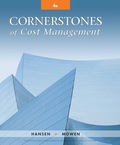
Concept explainers
Wright Plastic Products is a small company that specialized in the production of plastic dinner plates until several years ago. Although profits for the company had been good, they have been declining in recent years because of increased competition. Many competitors offer a full range of plastic products, and management felt that this created a competitive disadvantage. The output of the company’s plants was exclusively devoted to plastic dinner plates. Three years ago, management made a decision to add additional product lines. They determined that existing idle capacity in each plant could easily be adapted to produce other plastic products. Each plant would produce one additional product line. For example, the Atlanta plant would add a line of plastic cups. Moreover, the variable cost of producing a package of cups (one dozen) was virtually identical to that of a package of plastic plates. (Variable costs referred to here are those that change in total as the units produced change. The costs include direct materials, direct labor, and unit-based variable
Two years after the addition of the new product line, the profits of the Atlanta plant (as well as other plants) had not improved—in fact, they had dropped. Upon investigation, the president of the company discovered that profits had not increased as expected because the so-called fixed cost pool had increased dramatically. The president interviewed the manager of each support department at the Atlanta plant. Typical responses from four of those managers are given next.
Materials handling: The additional batches caused by the cups increased the demand for materials handling. We had to add one forklift and hire additional materials handling labor.
Inspection: Inspecting cups is more complicated than plastic plates. We only inspect a sample drawn from every batch, but you need to understand that the number of batches has increased with this new product line. We had to hire more inspection labor.
Purchasing: The new line increased the number of purchase orders. We had to use more resources to handle this increased volume.
Accounting: There were more transactions to process than before. We had to increase our staff.
Required:
- 1. Explain why the results of adding the new product line were not accurately projected.
- 2. Could this problem have been avoided with an activity-based cost management system? If so, would you recommend that the company adopt this type of system? Explain and discuss the differences between an activity-based cost management system and a traditional cost management system.
Trending nowThis is a popular solution!

Chapter 2 Solutions
EBK CORNERSTONES OF COST MANAGEMENT
- The ending balance of cash on hand for January.arrow_forwardWillow Inc. has $310,000 in accounts receivable on February 1. Budgeted sales for February are $1,050,000. Willow Inc. expects to sell 25% of its merchandise for cash. Of the remaining 75% of sales on account, 80% are expected to be collected in the month of sale and the remainder the following month. The February cash collections from sales are: a. $1,202,500 b. $840,000 c. $1,090,000 d. $1,400,000arrow_forwardBeta Corporation began operations on January 1 with cash of $100,000. All of January's $200,000 sales were on account. During January, no customer collections occurred. The cost of goods sold was $70,000, and there were no ending inventories or accounts payable. Use this information to determine the ending balance of cash on hand for January.Solve this ?arrow_forward
- Calculate Windsor Gear works total assets on these financial accounting questionarrow_forwardBeta Corporation began operations on January 1 with cash of $100,000. All of January's $200,000 sales were on account. During January, no customer collections occurred. The cost of goods sold was $70,000, and there were no ending inventories or accounts payable. Use this information to determine the ending balance of cash on hand for January.arrow_forwardNeed help with this financial accounting questionarrow_forward
 Cornerstones of Cost Management (Cornerstones Ser...AccountingISBN:9781305970663Author:Don R. Hansen, Maryanne M. MowenPublisher:Cengage Learning
Cornerstones of Cost Management (Cornerstones Ser...AccountingISBN:9781305970663Author:Don R. Hansen, Maryanne M. MowenPublisher:Cengage Learning
